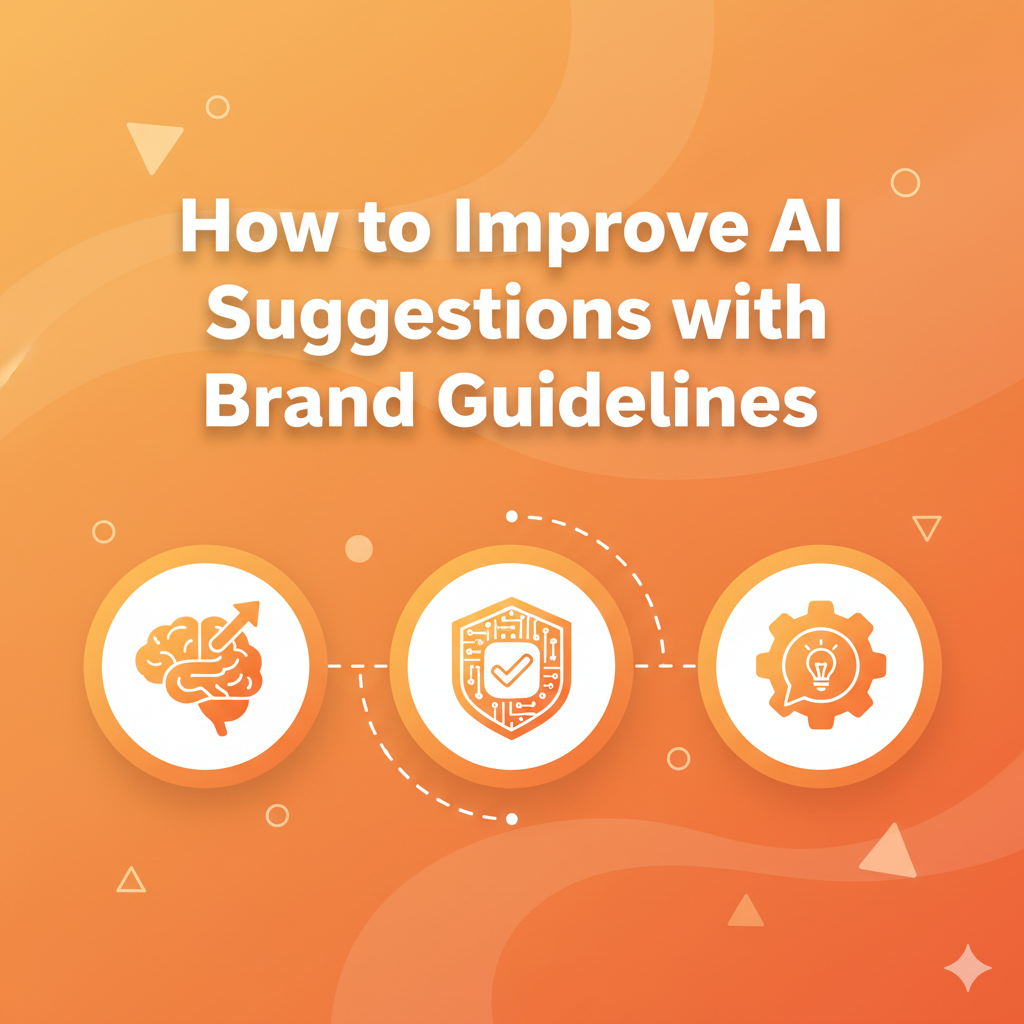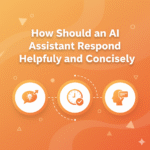When we use AI tools to write content, design visuals, or make marketing decisions, the suggestions we get are only as good as the context we give. If your AI doesn’t understand your brand, it can create results that sound robotic, look off-brand, or even send mixed signals to your audience.
That’s where brand guidelines come in. They’re not just for designers they’re the rulebook that helps AI stay consistent with your brand’s tone, message, and identity.
Let’s break down exactly how to do this step by step, in a realistic and practical way.
Why Brand Guidelines Matter for AI Suggestions
Think about how you train a new employee in your marketing team. You give them your brand book, explain your tone of voice, tell them what words to avoid, and show examples of what your brand sounds like.
Now imagine doing the same with an AI tool.
If your AI doesn’t “know” who you are as a brand, it will make generic suggestions — maybe good ones, but not you. The voice won’t feel right. The message might be correct, but the tone will be off.
Consistency is what builds trust in your brand. And if your AI-generated posts, ads, or visuals don’t sound consistent with your identity, that trust breaks down quickly.
So the first rule is this: AI needs brand context just like a human team member would.
Know What’s Inside Your Brand Guidelines
Before you can train your AI or shape its prompts, you need to be crystal clear on your brand identity.
Here’s what should be inside your brand guidelines:
a. Brand Voice and Tone
How does your brand sound? Are you friendly and conversational like a startup, or formal and authoritative like a consultancy? Define your tone — warm, informative, energetic, simple, or technical.
b. Visual Identity
Your colour palette, typography, logo usage, and overall visual personality matter even in AI image generation or design suggestions. If AI tools produce visuals, these are your creative boundaries.
c. Audience Definition
Who you’re speaking to shapes the language you use. AI suggestions for Gen Z customers will sound very different from suggestions for B2B clients.
d. Core Values
List your brand’s top values — such as trust, innovation, simplicity, or creativity. AI should reflect these in every piece of content it generates.
e. Messaging Rules
Define what your brand always says — your taglines, tone phrases, or catchphrases — and what it never says. This helps AI avoid words that don’t fit your identity.
f. Examples of On-Brand vs Off-Brand Content
Show AI (and your human team) examples of content that sounds perfect and content that doesn’t. These examples are gold when training or prompting AI systems.
Once you have this foundation, you can start embedding it into your AI workflow.
Start With Better Prompts: Giving AI the Right Context
This is the easiest and most practical step to start improving AI suggestions.
Your prompts are the instructions you give to AI — and they decide whether your output sounds like your brand or a random chatbot.
Here’s how I structure my prompts:
Example 1: For writing suggestions
“You are helping a brand called Pratham Writes, which has a friendly, professional, and honest tone. Avoid jargon and keep sentences short and conversational. The target audience is small business owners who want simple digital marketing advice. Create five headline suggestions that sound genuine and consistent with this voice.”
Example 2: For design suggestions
“Design ideas should use deep blue and white colours, minimalistic layouts, rounded typography, and a calm, trustworthy visual feel. Avoid flashy gradients or too many colours.”
Notice what’s happening here — I’m not just giving a task (“write a headline”), I’m feeding context: who we are, who we talk to, how we sound, and what we avoid.
That’s how you train AI to make suggestions that sound like you.
Embedding Brand Guidelines in AI Workflows
Once your prompts are set up, take it a step further. Create a structured AI suggestion workflow that reflects your brand at every step.
Step 1: Input Phase (Prompt + Context)
Every AI task starts with context. Include brand guidelines in every prompt or connect them via reference files (some AI tools allow that). The more you tell, the more it knows.
Step 2: Output Filtering
After AI gives its suggestions, review them for brand alignment. Ask:
- Does this sound like our tone of voice?
- Does it use approved language and style?
- Would our audience relate to this?
You can manually rate suggestions as “On Brand,” “Neutral,” or “Off Brand.” This rating system helps track which prompts or instructions work best.
Step 3: Human Review
AI suggestions should always pass through a human filter — especially for key materials like ad copy, campaign slogans, or website text. Humans understand emotional nuances that AI might miss.
Step 4: Feedback Loop
Collect feedback from your team or audience. Which AI-generated posts got the most engagement? Which ones felt slightly off?
Use this feedback to refine your prompts or brand instructions over time.
Fine-Tuning: Training AI to Understand Your Brand Deeper
If you’re using advanced tools or custom AI models, you can go beyond prompting and train your AI using your brand data.
Here’s what fine-tuning looks like:
- Feed it past brand-approved content (emails, blogs, social captions, design elements).
- Label each piece as “on-brand” or “off-brand.”
- The AI learns your tone, vocabulary, and preferences automatically.
This method works best for companies that use AI heavily for marketing, content, or design. Even if you’re a solo creator, you can start small — create your “brand dataset” of approved examples. Over time, your AI will adapt naturally.
Build a Brand-AI Playbook (Your Secret Weapon)
Once your prompts, workflows, and tone are figured out, document everything. Create a Brand-AI Playbook a simple, shareable document that defines how your AI should behave.
Here’s what to include:
- Brand Overview: Who you are, what you stand for.
- Voice & Tone: With examples and forbidden words.
- Prompt Templates: Ready-to-use instructions for writing, designing, brainstorming, or summarizing.
- Visual Style Notes: Colours, typography, image mood.
- Review Checklist: A list of questions to evaluate AI outputs before approval.
- Feedback Process: How you’ll track and improve results over time.
This document becomes your AI assistant’s “rulebook.” Even if you use different AI tools, you’ll maintain brand consistency across them all.
Create a Brand Vault for AI Reference
AI needs references just like humans do. That’s why I recommend building a brand vault — a folder that stores your best content and visual materials.
Inside this vault:
- Best-performing content pieces (posts, emails, articles)
- Approved visuals or campaigns
- Your tone-of-voice guide
- Do’s and Don’ts list
- Keywords your brand commonly uses
- Customer feedback highlights
Whenever AI makes suggestions, you can use snippets or references from this vault. Over time, AI will learn your preferences faster — and suggestions will become sharper, more accurate, and more authentic.
Run a Brand Compliance Audit
Every few weeks or months, conduct a brand compliance audit of your AI-generated content.
Ask:
- Is the tone consistent with our brand personality?
- Do visuals match our design style?
- Are we accidentally using off-brand words or phrases?
- Are we losing our unique voice over time?
AI can sometimes drift toward more generic patterns, especially when updates or model changes happen. Regular audits help you stay aligned and catch inconsistencies early.
Keep the Human Element Strong
This is one thing I always remind people AI should enhance your creativity, not replace it.
Even when AI gets smart enough to follow brand rules, human judgment is still irreplaceable.
Humans understand emotional timing, empathy, and subtle humor qualities AI can’t always replicate perfectly.
Use AI for speed, variety, and efficiency — but let humans handle the final voice, emotion, and storytelling. That’s where your brand’s soul lives.
Measure the Impact of Brand-Aligned AI Suggestions
If you want to see whether your AI improvements are paying off, track these metrics:
- Engagement rate on AI-assisted posts vs manual ones
- Consistency scores in your brand audits
- Time saved in creating and approving AI-generated content
- Brand perception or customer feedback on tone/voice
- Conversion or lead quality from brand-consistent campaigns
Once you start measuring, you’ll clearly see that brand-aligned AI outputs perform better. They connect more naturally with your audience and make your brand feel coherent everywhere — from blogs to social media.
Avoid These Common Mistakes
Let’s quickly address a few mistakes people make while integrating brand guidelines into AI workflows:
Mistake 1: Giving AI zero context
Saying “write a blog post about marketing” will never produce brand-accurate results. You need to give the AI your brand identity and tone every time.
Mistake 2: Assuming one prompt fits all
Your brand may use different tones for different channels — LinkedIn vs Instagram vs blog. Create separate prompt templates per channel.
Mistake 3: Ignoring updates
Your brand evolves over time — and your AI workflows should too. Keep updating prompts and examples as your brand grows.
Mistake 4: Letting AI go unreviewed
Always check for subtle inconsistencies — one wrong phrase or visual can make your audience question your authenticity.
Practical Example: How I Apply It
Let’s say I want AI to generate a few tagline suggestions for Pratham Writes.
Instead of typing “Give tagline ideas for a content marketing blog,” I would write:
“You’re helping a brand called Pratham Writes. The tone is conversational, realistic, and friendly — like a professional who talks simply, not formally. The audience is small business owners and marketers who prefer clear, practical advice. Generate 10 tagline suggestions that reflect clarity, authenticity, and expertise without sounding salesy.”
Now, AI suggestions will sound something like:
- “Writing that connects. Content that grows.”
- “Simple ideas. Real results.”
- “Smart writing for smart businesses.”
See the difference?
Because I gave context, the suggestions fit the brand naturally. They sound human, confident, and clear — exactly how I want my readers to perceive me.
Build for the Long Term
Improving AI suggestions with brand guidelines is not a one-time fix — it’s an evolving process.
As your brand grows, as your tone evolves, and as AI tools improve, you’ll keep refining your system.
Over time, your AI becomes smarter and more brand-aware.
It starts producing results that require fewer edits.
You save time, maintain quality, and build a strong brand voice that feels consistent across every channel.
That’s the long-term benefit of doing this right.
Quick Summary Checklist
If you’re in a hurry, here’s your Brand-AI Integration Checklist:
✅ Define your tone, voice, visuals, and values clearly.
✅ Create brand-based prompt templates for writing and design.
✅ Build a reference vault of your best-performing content.
✅ Review AI outputs for tone and consistency.
✅ Train or fine-tune models using approved brand data (optional).
✅ Maintain a brand-AI playbook for your team.
✅ Run monthly brand compliance audits.
✅ Keep updating guidelines and prompts as your brand evolves.
Wrapping Up
AI can be an incredible creative partner but only if it understands your brand.
The magic happens when your brand guidelines and AI work together like two parts of one system.
Your brand brings the personality.
AI brings the efficiency.
Together, they create suggestions that are not only smart but also authentically you.
That’s how I approach every piece of AI-assisted content I create. When your AI suggestions align perfectly with your brand’s identity, you don’t just create faster you create better.



Pingback: How AI Coding Agents Write Code Autonomously? (And What It Actually Means) - PratsDigital